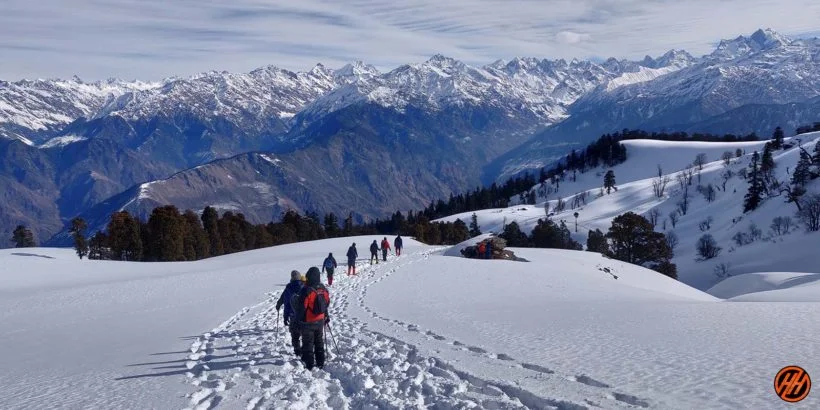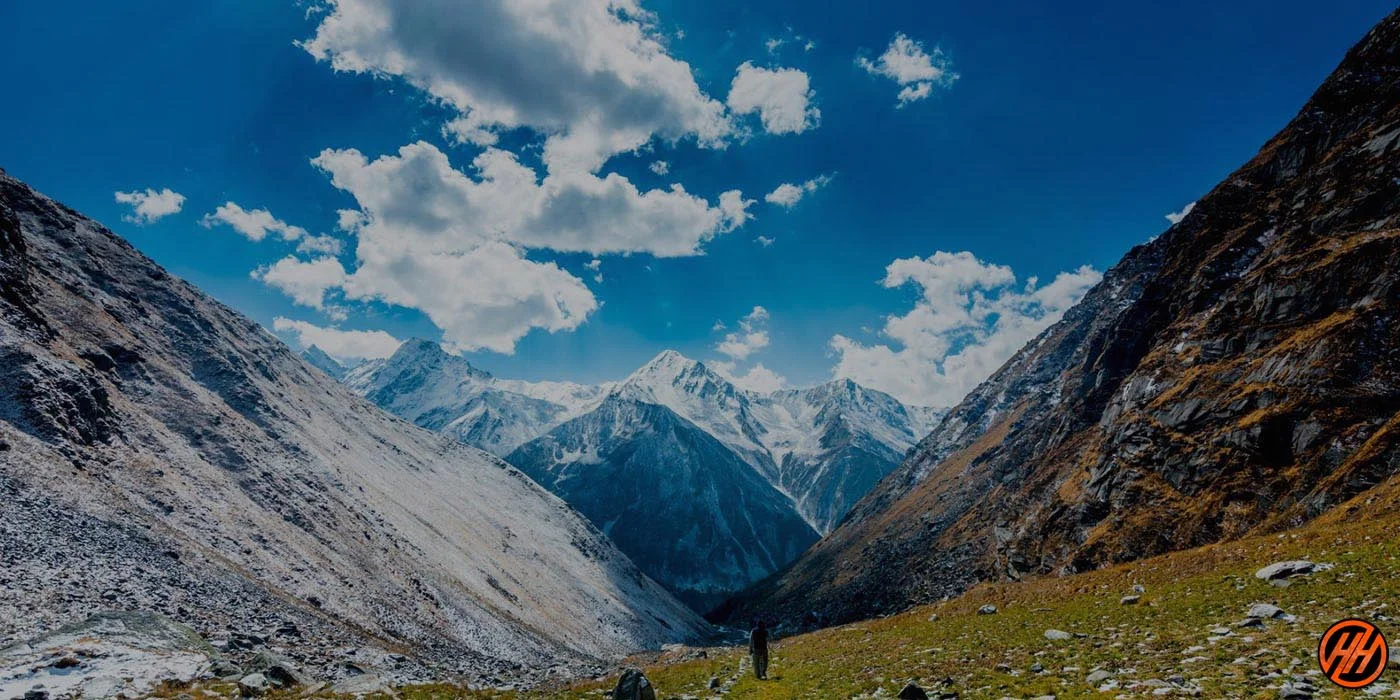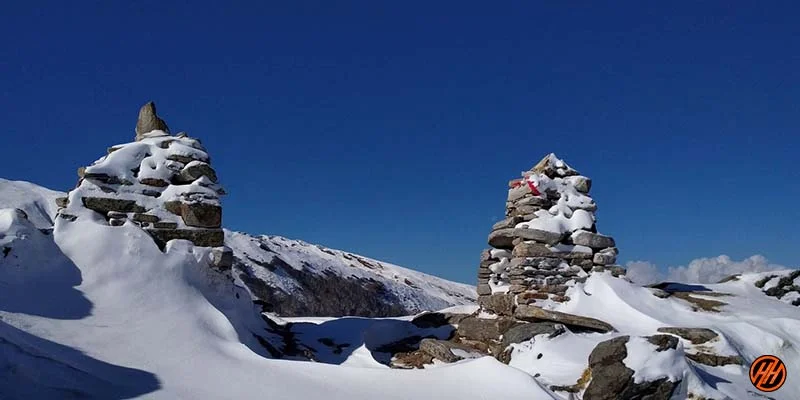Spent some memorable moments with loved ones in the Mountains
Your Trusted Trekking Partner for 34 Years
Guiding Over 25,000 Hikers Each Year to Explore Untouched Trails, Peaceful Landscapes, and Towering Snowy Summits
Guiding Over 25,000 Hikers Each Year to Explore Untouched Trails, Peaceful Landscapes, and Towering Snowy Summits

Snow Trek in Uttarakhand

Uttarakhand

Uttarakhand

Uttarakhand

Snow Trek in Uttarakhand

Uttarakhand

Uttarakhand

Frozen River Trek in Leh Ladakh

Himachal Pradesh

Uttarakhand

Snow Trek in Uttarakhand

Uttarakhand





Location & Geography: Kedarkantha is located in the Govind Wildlife Sanctuary in Uttarkashi district, Uttarakhand, India. Altitude: The summit is at 12,500 feet (3,800 meters) Terrain: The trail passes through dense pine forests, open meadows, charming villages, and snow-covered landscapes, offering a varied but manageable hiking experience. The region offers panoramic views of famous Himalayan peaks like Swargarohini, Bandarpoonch, and Black Peak. Route Overview: Base Village: Sankri (6,400 ft) – a scenic village with good accommodation options Trek Duration: 4–5 days (round trip), depending on itinerary Trail Highlights: Sankri → Juda Ka Talab → Kedarkantha Base Camp → Summit → Back to Sankri The gradual elevation gain and relatively short daily distances make it accessible for first-time trekkers.Suitable for All Age Groups: Age Range: Suitable for anyone from 8 to 60+ years, depending on fitness level Families, solo trekkers, and school groups frequently attempt the trek No prior trekking experience needed – ideal for students, working professionals, and senior citizens in good health Guided by Experienced Trek Leaders: Trek operators provide certified guides, support staff, and porters Safety measures include equipment like microspikes or gaiters in snow, and monitoring health at altitude Campsites are well-organized with tents, meals, and medical assistance Summary: Kedarkantha is perfect for beginners because it is safe, scenic, beginner-friendly, and rewarding. Its mix of adventure and accessibility makes it one of the most popular introductory treks in the Himalayas.

The Dayara Bugyal trek is one of Uttarakhand’s most scenic alpine meadows, which makes it perfect for beginners and nature lovers alike. Whether you’re chasing snow trails or walking through flower-filled pastures, timing your trek right can make all the difference. In this seasonal guide, we’ll walk you through the best time for Dayara Bugyal Trek, explore how the terrain changes through the year, and help you pick the season that suits your adventure style best. Summer (May–June): Rolling Meadows in Full Bloom If you’re drawn to wide-open green landscapes and crisp mountain air, summer is the best time for Dayara Bugyal Trek in summer. This is when the meadows are lush, the skies are clear, and the wildflowers begin to bloom. Highlights: Golden-green pastures and blossoming rhododendrons Warm days and cool evenings — perfect trekking weather Ideal for photography and beginners Day Temperature: 8°C – 15°C Crowd: Moderate (family trekkers and school groups often visit during this time) Winter (December–February): A Snow-Covered Wonderland For a magical snow trek experience, the best time for Dayara Bugyal trek in winter is from mid-December to early February. The trail transforms into a snowy wonderland, with powder-white landscapes and frozen forests. Highlights: A true winter trek with knee-deep snow Less crowded, serene trails Perfect for those seeking solitude and snow-play Day Temperature: -5°C to 10°C Crowd: Low to moderate — often fewer trekkers due to colder weatherAutumn (September–November): Clear Views and Golden Trails After the monsoon, Dayara Bugyal offers crystal-clear views of the Bandarpoonch and Draupadi Ka Danda peaks. The meadow turns golden brown, and the skies stay brilliantly blue. Highlights: Dry trails and cool, pleasant trekking conditions Fewer tourists makes it ideal for peaceful travel Excellent visibility for photography and stargazing Day Temperature: 5°C – 12°C Crowd: Low to moderate Monsoon (July–August): Best Avoided While the bugyals are at their greenest during the monsoon, the Dayara Bugyal trek during this time of year isn’t ideal for trekking. Heavy rainfall can make the trails slippery and risky, with frequent landslides and limited visibility. Dayara Bugyal Trek at a Glance Trek Duration: 4 Days – 3 Nights Trek Difficulty: Easy to Moderate Total Trek Distance: 30 km (round trip) Distance from Delhi to Dayara Bugyal Base Camp: 450 km Distance from Dehradun Airport to Dayara Bugyal Base Camp: 200 km Trek Starting Point: Raithal village (Dayara Bugyal Base Camp) How to Reach Dayara Bugyal From Delhi: Approx. 450 km via Rishikesh and Uttarkashi Nearest Airport: Jolly Grant Airport, Dehradun (200 km from Raithal) Trek Route: Dehradun → Raithal → Gui → Dayara Bugyal So, when is the best time for the Dayara Bugyal Trek? The ideal time to visit Dayara Bugyal trek depends on what you expect from this alpine trek: For lush green meadows and blooming beauty: May to June For a snowy fairytale trek: December to February\ For peaceful trails and mountain views: September to November No matter when you go, Dayara Bugyal delivers. Just choose your season, lace up your boots, and let the Himalayas take care of the rest.

Should You Do the Har Ki Dun Trek in 2025? What No One Tells You The mighty Himalayas have always called out to the adventurous soul. And among the hundreds of treks scattered across its vast folds, the Har Ki Dun Trek stands as one of the most serene, myth-rich, and soul-touching experiences in India. But in 2025, with changing trail regulations, rising eco-tourism, and an evolving trekking culture, many wanderers are asking — is it still worth it? Let us take you deep into the forests of Govind Pashu Vihar, to the riverside trails, through sleepy Himalayan villages — and help you decide if Har Ki Dun truly deserves a spot on your 2025 bucket list. What Makes Har Ki Dun Trek Special in 2025? Myths, Views & Real Trekker Insights 1. The Mythological Connection Still Breathes Here Har Ki Dun, literally meaning "Valley of the Gods," is believed to be the route taken by the Pandavas on their final journey to heaven. The village of Osla, perched on a mountain slope, even houses a Duryodhana temple — a rare devotion to the otherwise infamous Kaurava prince. For spiritual seekers and mythology lovers, trekking here is like walking through a living epic. 2. Forests, Rivers & Mountains — Nature’s Tranquil Trifecta In 2025, when most treks are getting crowded and commercial, Har Ki Dun still offers peaceful trails lined with pine forests, wildflowers, gurgling streams, and the mighty Swargarohini peaks always watching you. The valley opens up like a painting — untouched, unhurried, and deeply refreshing. 3. A Photographer’s and Birder’s Paradise Expect sightings of monals, barbets, and even Himalayan griffons. Mornings are golden, evenings are moody, and clouds play hide and seek with snow-capped peaks. Carry a good lens — the valley won’t disappoint. 4. Friendly for Beginners Yet Deeply Satisfying With a well-paced itinerary and moderate difficulty, this trek is perfect for those new to high-altitude hiking. But it also has the kind of depth — in views, stories, and silence — that even seasoned trekkers respect. 5. The Local Culture is Alive, Not Packaged In Osla and other villages en route, life flows in its ancient rhythm. Shepherds pass by with their flocks, women still wear traditional woollen dresses, and wooden homes stand strong against time. 2025 hasn’t dulled their authenticity yet.Pros & Cons – A Real Trekker’s Perspective Pros: Unmatched serenity and cultural richness Beginner-friendly terrain Myths & legends on every bend Stunning campsites (Seema, Har Ki Dun base, Kalkatti Dhar) Clean, forest-protected trails Cons: Long drive to base camp (Sankri takes 9–10 hours from Dehradun) Weak to no network after Purola Limited snow in peak winter compared to Kedarkantha Slightly longer duration (7–8 days) Final Verdict – Is It Worth It? If you’re looking for snow slides, heavy climbs, or Instagram reels — you may find other treks more thrilling. But if you seek something raw, spiritual, quiet, and profound — Har Ki Dun in 2025 is more than worth it. It’s not just a trek. It’s a gentle pilgrimage through the oldest myths of the Mahabharata, a walk through living Himalayan heritage, and a reminder that sometimes, the slower journeys are the ones that stay with us the longest. Book Har Ki Dun Trek with Trusted Experts Himalayan Hikers: Click Here

Important Safety Trekking Guidelines for Trekkers Before the Trek Follow Company Rules – Abide by all trek policies, safety protocols, and instructions given before and during the trek. These rules exist to protect you and your team. Listen to Your Guide – Your trek leader and guides know the route, weather conditions, and potential hazards. Follow their directions without hesitation or argument. Stay with the Group – Never leave the team or take shortcuts. Staying together ensures everyone’s safety. No Panic, No Rushing – During heavy rain, slippery paths, or emergencies, remain calm. Move slowly and in an orderly fashion. Pay Attention to Emergency Signals – Whistles, hand gestures, or verbal calls from your guide carry important instructions. Stop immediately and listen. Respect Nature – Avoid disturbing wildlife, do not litter, and protect the environment. Be Weather-Ready – Carry waterproof gear, warm layers, and extra clothing. Mountain weather changes quickly. Hydrate and Eat Regularly – Keep your energy levels up. Carry adequate water and snacks. Know Your Limits – Do not overexert yourself. Inform your guide if you feel unwell. Carry Essentials – Always have a small first-aid kit, flashlight, and personal medication. During the Trek Stay With the Group – Never wander off alone. No Shortcuts – Stick to the marked trails. Move Carefully – Avoid rushing, especially on slippery paths. No Panic – Stay calm during emergencies or sudden weather changes. Observe Signals – Listen to whistles, hand signals, or verbal instructions from the guide. Hydrate Regularly – Drink water frequently, even if not thirsty. Eat Properly – Keep your energy up with light snacks. Use Trekking Poles – Helps with balance on difficult terrain. Avoid Risky Areas – Steep edges, loose rocks, or fast-flowing streams. Respect Wildlife – Do not provoke or feed animals. Weather & Terrain Safety Carry Waterproof Gear – Jacket, backpack cover, and rain boots if needed. Layer Your Clothing – Prevent hypothermia in cold or wet conditions. Avoid Low Areas During Rain – Flooding risk. Be Cautious with Lightning – Stay away from isolated trees or high points. Check Trail Conditions – Mud, rocks, and ice can be hazardous. Keep Electronics Protected – Use waterproof pouches for phones, GPS, and cameras. Behavior & Team Safety Communicate Openly – Inform your guide if you feel unwell or tired. Help Others – Support fellow trekkers who need assistance. Leave No Trace – Carry trash back, do not litter, and protect the environment. Stay Positive & Alert – A calm, focused mind reduces accidents and ensures a safe, enjoyable trek with Himalayan Hikers.
Winter trek booking are now open! Avail our early bird discount and exciting group offers. Hurry up join our upcoming fix departure trek with team Himalayan Hikers and make your winter Trek truly unforgettable.
If you have doubts or trouble registering for a trek, use this section to troubleshoot your problems.
We are serving in the field of adventure with a great experience of 34 years. There are many trekking companies and it is very important to choose the right one. Being the local experts our professional team has proper knowledge of mountain terrains, mountaineering skills, and real-life experiences.
After our first priority of safety, we take proper care of accommodation, food, and equipment. The quality of service is never compromised. While planning your treks Himalayan Hikers always try to bring you close to the environment by providing sustainable treks. We help you explore the culture of quaint villages and provide delicious traditional food from different places, so jump out of your comfort zone and get once-in-a-lifetime experiences with our team.
Yes, we arrange customized treks. They are more comfortable than the fixed departures. In these treks, you can extend or reduce the itinerary or add extra activity to it at the time of booking.
Yes, we provide trek gear on rent. Trekking demands a good investment and this extremely expensive activity is the passion of many, so we have a great announcement to make which will be a great relief to your pockets. Now, you can get your Trekking Gear on Rent and all you have to do is make a special renting request while booking your trek. That’s it! We have kept it simple for you.
There are always some risks in the adventure and without the challenges it is tasteless. But, safety is a measure that cannot be ignored at any cost. Many challenges will be thrown in front but if handled properly you can easily overcome them. Himalayan Hikers provide the safest treks to their trekkers.
Yes, why not? You can go on a trek even if you are above 50 and have little trekking experience. However, we recommend choosing an easy-to-moderate trek and preparing in advance with regular walking, cardio exercises, and strength training. It's also advisable to consult your doctor before undertaking a high-altitude trek. If needed, our team can guide you in selecting a suitable trek based on your fitness level.
At each of our hotels or base camps, we provide concrete washrooms in both Indian and Western styles, ensuring comfort and convenience for all trekkers. During the trek, we set up separate bio-toilets for men and women. To minimize environmental impact, we encourage trekkers to use toilet paper instead of wet wipes.
In remote regions, you cannot use debit or credit cards so on your trek carry enough cash in Indian currency (Rupee). With every trek mentioned on our website, we have given the details of the last ATM point and Mobile Connectivity.
You can find more information on our website’s Contact Us page.
Hotels and guesthouses with bathroom facilities in remote regions use solar systems or gas to heat water so it depends if you get hot water or not. During the trek, the water sources are less and the weather remains cold so you would not even think of taking a shower..
You can charge the batteries only in the hotel. There will be no electricity during the trek so keep your batteries charged and bring extra battery backup.

















This category organizes trekking routes into different classifications to help trekkers find trails that suit their preferences, skills, and requirements. Whether you’re looking for a trek based on the season, duration, difficulty, region, or your trekking experience, this approach makes it easier to choose the perfect adventure for your needs.